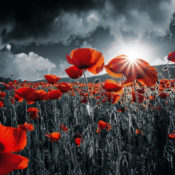 The idea of a military draft has never sat comfortably with Americans. When conscription was introduced during the Civil War, it sparked a three-day riot in New York that left over a hundred dead and hundreds more injured.
The idea of a military draft has never sat comfortably with Americans. When conscription was introduced during the Civil War, it sparked a three-day riot in New York that left over a hundred dead and hundreds more injured.
When President Woodrow Wilson called for a new draft in 1917, the country’s response was divided. Some, like the editors of the Post, strongly supported bringing back conscription, as seen in this April 7, 1917, editorial, “Raising an Army,” written just days before Congress declared war and published the day after.

Others expected the new draft to be met with violence. One Missouri senator told the secretary of war that a draft would result in “the streets of our American cities running red with blood.” The speaker of the house declared there was “precious little difference between a conscript and a convict.”
Even the judge advocate general of the U.S. Army said that “a military draft is not in harmony with the spirit of our people. All our previous experience has been that it causes trouble and that our people prefer the volunteering method.” Yet it was this same man, General Enoch Crowder, who successfully launched the new Selective Service System.
Crowder made the draft more acceptable to the public by putting it under local, civilian control. Starting in the spring of 1917, the Selective Service set up 4,648 boards run by “responsible citizens” — county clerks, lawyers, doctors, and community leaders. Rather than military officers choosing which boys to send into war, the draftee’s neighbors and friends would hold the responsibility.
On June 5, during the first registration (there would be two more), these boards — which covered all 48 states, the District of Columbia, and the territories of Alaska, Hawaii, and Puerto Rico — began registering every American man between the ages of 21 and 30. The boards then determined which men were available for military service.
Each man was issued a registration number between 1 and 10,500 (the maximum number registered with any draft board). On July 20, a lottery determined the number holder’s eligibility for service.
How successful was Crowder’s Selective Service? Between June 1917 and November 1918, it registered 24 million men and sent nearly 3 million into the Army. (Neither the Navy nor the Marines wanted draftees in their ranks.)
Among the drafted men were 64,000 who requested to be listed as noncombatants. Despite widespread suspicion that these conscientious objectors were cowards, malingerers, or enemy agents, almost 90 percent of the requests were granted.
It is interesting to note that 16,000 of the conscientious objectors eventually changed their minds about fighting. One of these was Medal of Honor recipient Alvin York. After a minister convinced him that military service was compatible with his faith, York rose to the rank of sergeant and, one day in 1918, infiltrated the German lines, seized 35 machine guns, and killed or captured more than 150 enemy soldiers.
Despite the apparent success of the Selective Service, the system wasn’t any more perfect than the Americans it served. For example, the state of public health in America was so bad in 1917 that one-third of the conscripts were rejected for medical reasons. Another problem was draft dodgers. Crowder estimated that 3.6 million men never even registered. And of those who registered and were conscripted, 12 percent dodged military service.
Crowder had made the draft less objectionable to Americans, but he never eliminated their dislike of the program. Resistance to the draft climbed steadily during the Vietnam War years. Of the 27 million men eligible for military duty between 1964 and 1973, the Selective Service chose 2.2 million. Over 15 million deferred their service, mostly to finish a college degree program, which many did as slowly as possible. Over 200,000 avoided the draft illegally, 100,000 deserted, and an estimated 10,000 to 30,000 fled to Canada.
We won’t know if Americans’ attitude toward the draft has changed until the next draft is called.
Featured image: Saturday Evening Post cover by Julian De Miskey from May 11, 1918 (SEPS)
Become a Saturday Evening Post member and enjoy unlimited access. Subscribe now



